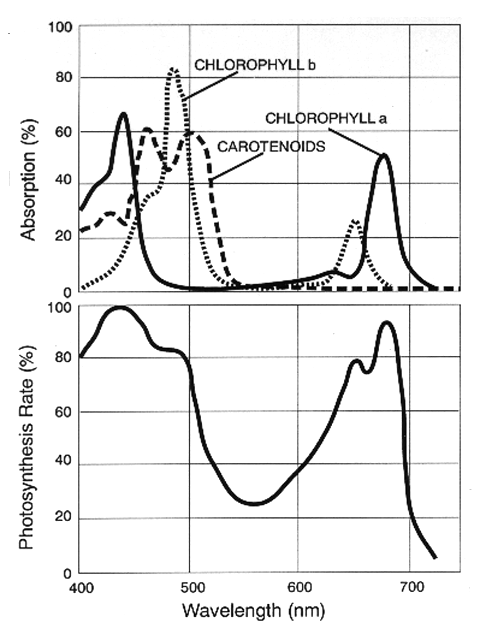P
purpledomgoddes
conversion from foot-candles to w(watts) per m2(meter squared)
(for wavelengths of 400-850 nm(nanometers):
types of light multiply fc(foot candles) by:
-fluorescent
cool white 0.032
warm white 0.031
grow-lux plant light 0.069
grow-lux wide spectrum 0.047
agro-lite 0.043
vita-lite 0.041
hid(high intensity discharge)
mercury vapor 0.030
metal halide 0.037
high pressure sodium 0.036
low pressure sodium 0.023
incandescent
standard 0.093
mercury 0.065
daylight: 0.060
luminous flux: the rate of emission of light from a source with respect to the sensitivity of the human eye, measured in lumens.
illuminance: the luminous flux density incident on a surface, in lumens per square meter expressed in lux(lx). or lumens per square foot.(lm/ft2)
irradiane: the radiant flux density incident on a surface; that is, the radiant energy received by a surface. the units are watts per square meter(w/m2) or milliwatss per sqaure meter(mw/m2) or in watts or milliwatts per square foot.
luminous efficacy: the ratio of total luminous flux emitted by a lamp to the energy consumed expressed in lumens per watt (lm/w).
the best unit for expressing the energy requirement of a specific plant species is the irradiance expressed in milliwatts per sqaure meter or milliwatts per square foot(mw/m2,mw/ft2). it is the measure of the quantity of energy in wavelength band 400-700 nanometers(nm) received by the plants.
to more accurately compare different light sources, a meter that measures par(photosynthethically active radiation) is desirable. while the photometer measures the brightness sensation of the human gene, the par meter measures the energy in the 400-700 nanometers(nm) wavelengths received by plants.
(for wavelengths of 400-850 nm(nanometers):
types of light multiply fc(foot candles) by:
-fluorescent
cool white 0.032
warm white 0.031
grow-lux plant light 0.069
grow-lux wide spectrum 0.047
agro-lite 0.043
vita-lite 0.041
hid(high intensity discharge)
mercury vapor 0.030
metal halide 0.037
high pressure sodium 0.036
low pressure sodium 0.023
incandescent
standard 0.093
mercury 0.065
daylight: 0.060
luminous flux: the rate of emission of light from a source with respect to the sensitivity of the human eye, measured in lumens.
illuminance: the luminous flux density incident on a surface, in lumens per square meter expressed in lux(lx). or lumens per square foot.(lm/ft2)
irradiane: the radiant flux density incident on a surface; that is, the radiant energy received by a surface. the units are watts per square meter(w/m2) or milliwatss per sqaure meter(mw/m2) or in watts or milliwatts per square foot.
luminous efficacy: the ratio of total luminous flux emitted by a lamp to the energy consumed expressed in lumens per watt (lm/w).
the best unit for expressing the energy requirement of a specific plant species is the irradiance expressed in milliwatts per sqaure meter or milliwatts per square foot(mw/m2,mw/ft2). it is the measure of the quantity of energy in wavelength band 400-700 nanometers(nm) received by the plants.
to more accurately compare different light sources, a meter that measures par(photosynthethically active radiation) is desirable. while the photometer measures the brightness sensation of the human gene, the par meter measures the energy in the 400-700 nanometers(nm) wavelengths received by plants.
Last edited:





